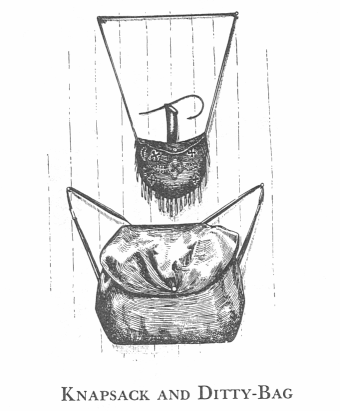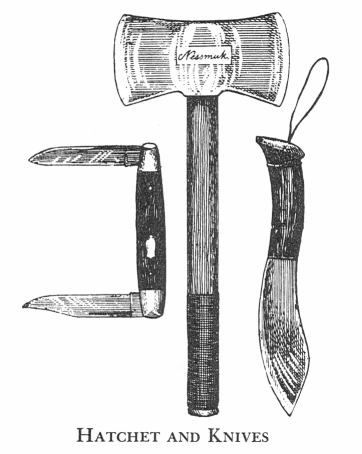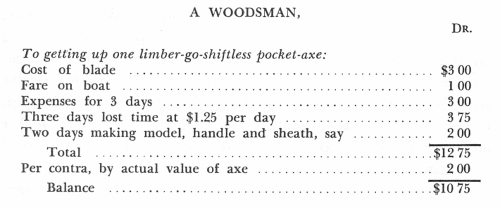CHAPTER II
Knapsack, Hatchet, Knives, Tinware, Fishing Tackle, Rods, Ditty-bag
THE clothing, blanket-bag and shelter-cloth are all that need be described in that line. The next articles that I look after are knapsack (or pack basket), rod with reel, lines, flies, hooks and all my fishing gear, pocket-axe, knives and tinware. Firstly, the knapsack; as you are apt to carry it a great many miles, it is well to have it right and easy-fitting at the start. Don't be induced to carry a pack basket. I am aware that it is in high favor all through the Northern Wilderness and is also much used in other localities where guides and sportsmen most do congregate. But I do not like it. I admit that it will carry a loaf of bread, with tea, sugar, etc., without jamming; that bottles, crockery and other fragile duffle is safer from breakage than in an oil-cloth knapsack. But it is by no means waterproof in a rain or a splashing head sea, is more than twice as heavy—always growing heavier as it gets wetter—and I had rather have bread, tea, sugar, etc., a little jammed than water-soaked. Also, it may be remarked that man is a vertebrate animal and ought to respect his backbone. The loaded pack basket on a heavy carry never fails to get in on the most vulnerable knob of the human vertebrae. The knapsack sits easy and does not chafe. The one shown in the engraving is of good form; and the original—which I have carried for years—is satisfactory in every respect. It holds over half a bushel, carries blanket-bag, shelter-tent, hatchet, ditty-bag, tinware, fishing tackle, clothes and two days' rations. It weighs, empty, just twelve ounces.

The hatchet and knives shown in the engraving will be found to fill the bill satisfactorily so far as cutlery may be required. Each is good and useful of its kind, the hatchet especially, being the best model I have ever found for a "double-barreled" pocket-axe.

And just here let me digress for a little chat on the indispensable hatchet; for it is the most difficult piece of camp kit to obtain in perfection of which I have any knowledge. Before I was a dozen years old I came to realize that a light hatchet was a sine qua non Latin: Essential, indispensable. in woodcraft and I also found it a most difficult thing to get. I tried shingling hatchets, lathing hatchets and the small hatchets to be found in country hardware stores, but none of them were satisfactory. I had quite a number made by blacksmiths who professed skill in making edged tools and these were the worst of all, being like nothing on the earth or under it—murderous-looking, clumsy and all too heavy, with no balance or proportion. I had hunted twelve years before I caught up with the pocket-axe I was looking for. It was made in Rochester, by a surgical instrument maker named Bushnell. It cost time and money to get it. I worked one rainy Saturday fashioning the pattern in wood. Spoiled a day going to Rochester, waited a day for the blade, paid $3.00 for it and lost a day coming home. Boat fare $1.00 and expenses $2.00, besides three days lost time, with another rainy Sunday for making leather sheath and hickory handle.
My witty friends, always willing to help me out in figuring the cost of my hunting and fishing gear, made the following business-like estimate, which they placed where I would be certain to see it the first thing in the morning. Premising that of the five who assisted in that little joke, all stronger, bigger fellows than myself, four have gone "where they never see the sun," I will copy the statement as it stands today, on paper yellow with age. For I have kept it over forty years.

Then they raised a horse laugh and the cost of that hatchet became a standing joke and a slur on my "business ability." What aggravated me most was, that the rascals were not so far out in their calculation. And was I so far wrong? That hatchet was my favorite for nearly thirty years. It has been "upset" twice by skilled workmen; and, if my friend Bero has not lost it, is still in service.
Would I have gone without it any year for one or two dollars? But I prefer the double blade. I want one thick, stunt edge for knots, deers' bones, etc. and a fine, keen edge for cutting clear timber.
A word as to knife, or knives. These are of prime necessity and should be of the best, both as to shape and temper. The "bowies" and "hunting knives" usually kept on sale, are thick, clumsy affairs, with a sort of ridge along the middle of the blade, murderous-looking, but of little use; rather fitted to adorn a dime novel or the belt of "Billy the Kid," than the outfit of the hunter. The one shown in the cut is thin in the blade and handy for skinning, cutting meat, or eating with. The strong double-bladed pocket knife is the best model I have yet found and, in connection with the sheath knife, is all sufficient for camp use. It is not necessary to take table cutlery into the woods. A good fork may be improvised from a beech or birch stick; and the half of a fresh-water mussel shell, with a split stick by way of handle, makes an excellent spoon.
My entire outfit for cooking and eating dishes comprises five pieces of tinware. This is when stopping in a permanent camp. When cruising and tramping, I take just two pieces in the knapsack.
I get a skillful tinsmith to make one dish as follows: Six inches on bottom, 6 3/4 inches on top, side 2 inches high. The bottom is of the heaviest tin procurable, the sides of lighter tin and seamed to be watertight without solder. The top simply turned, without wire. The second dish to be made the same, but small enough to nest in the first and also to fit into it when inverted as a cover. Two other dishes made from common pressed tinware, with the tops cut off and turned, also without wire. They are fitted so that they all nest, taking no more room than the largest dish alone and each of the three smaller dishes makes a perfect cover for the next larger. The other piece is a tin camp-kettle, also of the heaviest tin and seamed watertight. It holds two quarts and the other dishes nest in it perfectly, so that when packed the whole takes just as much room as the kettle alone. I should mention that the strong ears are set below the rim of the kettle and the bale falls outside, so, as none of the dishes have any handle, there are no aggravating "stickouts" to wear and abrade. The snug affair weighs, all told, two pounds. I have met parties in the North Woods whose one frying pan weighed more—with its handle three feet long. However did they get through the brush with such a culinary terror?
It is only when I go into a very accessible camp that I take so much as five pieces of tinware along. I once made a ten days' tramp through an unbroken wilderness on foot and all the dish I took was a ten-cent tin; it was enough. I believe I will tell the story of that tramp before I get through. For I saw more game in the ten days than I ever saw before or since in a season; and I am told that the whole region is now a thrifty farming country, with the deer nearly all gone. They were plenty enough thirty-nine years ago this very month.
I feel more diffidence in speaking of rods than of any other matter connected with outdoor sports. The number and variety of rods and makers; the enthusiasm of trout and fly "cranks"; the fact that angling does not take precedence of all other sports with me, with the humiliating confession that I am not above bucktail spinners, worms and sinkers, minnow tails and white grubs—this and these constrain me to be brief.
But, as I have been a fisher all my life, from my pinhook days to the present time; as I have run the list pretty well up, from brook minnows to 100 pound albacores, I may be pardoned for a few remarks on the rod and the use thereof.
A rod may be a very high-toned, high-priced aesthetic plaything, costing $50 to $75, or it may be a rod. A serviceable and splendidly balanced rod can be obtained from first class makers for less money. By all means let the man of money indulge his fancy for the most costly rod that can be procured. He might do worse. A practical every day sportsman whose income is limited will find that a more modest product will drop his flies on the water quite as attractively to Salmo fontinalis Brook trout.. My little 8 1/2 foot, 4 1/2 ounce split bamboo which the editor of Forest and Stream had made for me cost $10.00. I have given it hard usage and at times large trout have tested it severely, but it has never failed me. The dimensions of my second rod are 9 1/2 feet long and 5 ounces in weight. This rod will handle the bucktail spinners which I use for trout and bass, when other things have failed. I used a rod of this description for several summers both in Adirondack and western waters. It had a hand-made reel seat, agate first guide, was satisfactory in every respect and I could see in balance, action and appearance no superiority in a rod costing $25.00, which one of my friends sported. Charles Dudley Warner, who writes charmingly of woods life, has the following in regard to trout fishing, which is so neatly humorous that it will bear repeating:
"It is well known that no person who regards his reputation will ever kill a trout with anything but a fly. It requires some training on the part of the trout to take to this method. The uncultivated trout in unfrequented waters prefers the bait; and the rural people, whose sole object in going a-fishing appears to be to catch fish, indulge them in their primitive state for the worm. No sportsman, however, will use anything but a fly except he happens to be alone." Speaking of rods, he says:
"The rod is a bamboo weighing seven ounces, which has to be spliced with a winding of silk thread every time it is used. This is a tedious process; but, by fastening the joints in this way, a uniform spring is secured in the rod. No one devoted to high art would think of using a socket joint."
One summer during a seven weeks' tour in the Northern Wilderness, my only rod was a 7 1/2 foot Henshall. It came to hand with two bait-tips only; but I added a fly-tip and it made an excellent "general fishing rod." With it I could handle a large bass or pickerel; it was a capital bait-rod for brook trout; as fly-rod it has pleased me well enough. It is likely to go with me again. For reel casting, the 5 1/2 foot rod is handier. But it is not yet decided which is best and I leave every man his own opinion. Only, I think one rod enough, but have always had more.
And don't neglect to take what sailors call a "ditty-bag." This may be a little sack of chamois leather about 4 inches wide by 6 inches in length. Mine is before me as I write. Emptying the contents, I find it inventories as follows: A dozen hooks, running in size from small minnow hooks to large Limericks; four lines of six yards each, varying from the finest to a size sufficient for a ten-pound fish; three darning needles and a few common sewing needles; a dozen buttons; sewing silk; thread and a small ball of strong yarn for darning socks; sticking salve Make from various ingredients (pitch, rosin, petroleum jelly, lard, etc.) and including herbs. Used as a healing agent on wounds.; a bit of shoemaker's wax; beeswax; sinkers and a very fine file for sharpening hooks. The ditty-bag weighs, with contents, 2 1/2 ounces; and it goes in a small buckskin bullet pouch, which I wear almost as constantly as my hat. The pouch has a sheath strongly sewed on the back side of it, where the light hunting knife is always at hand, and it also carries a two-ounce vial of fly medicine, a vial of "pain killer," and two or three gangs of hooks on brass wire snells—of which, more in another place. I can always go down into that pouch for a waterproof match safe, strings, compass, bits of linen and scarlet flannel (for frogging), copper tacks and other light duffle. It is about as handy a piece of woods-kit as I carry.
I hope no aesthetic devotee of the fly-rod will lay down the book in disgust when I confess to a weakness for frogging. I admit that it is not high-toned sport; and yet I have got a good deal of amusement out of it. The persistence with which a large batrachian Vertebrate amphibians without tails, such as frogs and toads. will snap at a bit of red flannel after being several times hooked on the same lure and the comical way in which he will scuttle off with a quick succession of short jumps after each release; the cheerful manner in which, after each bout, he will tune up his deep, bass pipe—ready for another greedy snap at an ibis fly or red rag is rather funny. And his hind legs, rolled in meal and nicely browned, are preferable to trout or venison.